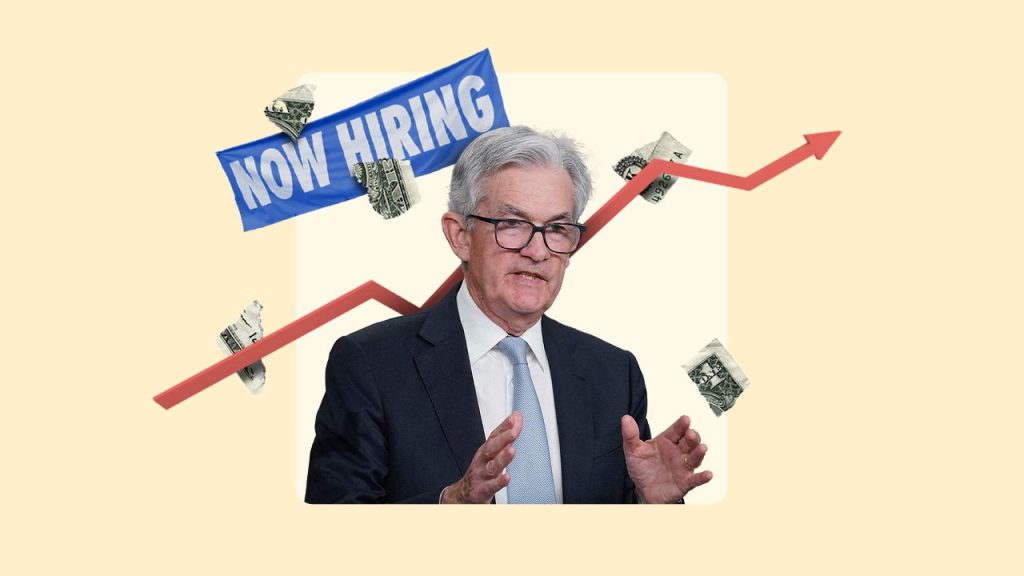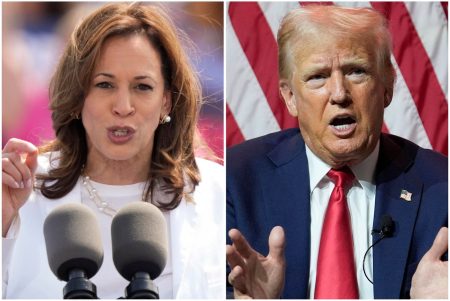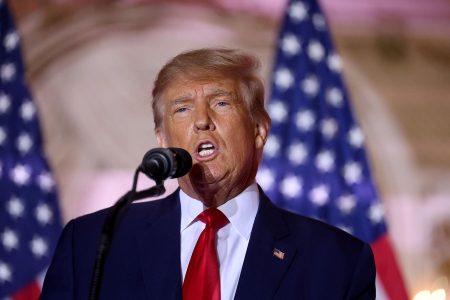To the outside viewer, the Federal Reserve looks like it’s come close to achieving the impossible soft landing of the U.S. economy. Interest rates are the highest in more than 20 years and inflation is nearly a third of what it used to be, yet unemployment remains historically low and a recession is nowhere to be found.
The nation’s top economists, however, say the U.S. central bank might not want to get too comfortable just yet.
A severe recession doesn’t look like it’s around the corner, but a slowdown could be, according to forecasts from Bankrate’s Second-Quarter Economic Indicator Survey. Unemployment is expected to hit an almost three-year high, and over the next 12 months, employers are projected to create about half as many jobs. Driving the moderating economic environment is a Fed determined to keep interest rates high. The Fed is expected to begin modestly cutting interest rates in September as inflation takes through the end of 2025 — or longer — to return to its official 2 percent goalpost, economists say.
Signs are already pointing to a deceleration from a rapid post-pandemic boom — albeit not in a way that’s raising any alarm bells just yet. For the first time since November 2021, joblessness is now at 4.1 percent, still historically low but up from 3.4 percent last year. The number of job openings per every unemployed worker is back to levels last seen before the outbreak. Wages, meanwhile, are still growing faster than they were before the pandemic, but firms are no longer offering the giant pay bumps exclusive to the early months of the economy’s reopening.
The economy’s full-year story is yet to be written. The good news is that the U.S. economy has continued to avoid a recession. The headwinds of elevated prices and high interest rates, however, are being felt, with the unemployment rate edging up from a multi-decade low.
— Mark Hamrick, Bankrate Senior Economic Analyst
Bankrate has been polling the nation’s top economists on their expectations for the job market, inflation, the Federal Reserve, economic growth and more on a quarterly basis for almost a decade. Read on for the latest findings.
Key insights on the economy from Bankrate’s Q2 2024 Economic Indicator poll
Unemployment seen hitting a near three-year high by June 2025
The U.S. jobs market is no underdog. For two consecutive years, employers have added the most jobs in a 12-month period since 1999, while the unemployment rate held below 4 percent for the longest stretch of time since the 1960s.
Hiring has also dodged the slowdown most economists have been expecting. Back in March 2023, the nation’s top economists thought the unemployment rate would hit 4.6 percent by March 2024 and employers would be cutting jobs. Instead, unemployment only rose to 3.8 percent, and on average, employers added 242,000 jobs each month over the 12-month period. Economists have been adjusting accordingly, each quarter expecting a slowdown that isn’t as fierce as the one they were expecting in the prior-polling period.
Yet, the message remains clear: Economists are still expecting the job market to decelerate. By June 2025, the unemployment rate is expected to hit 4.3 percent, and employers are expected to create 115,000 jobs each month, on average, over the next 12 months, down from the previous 12-month pace of 218,000, according to economists’ average forecast.
Every economist expects unemployment to be higher than it is now and hiring to slow from its current pace. Responses ranged from a low of 4.1 percent to as high as 5 percent for the unemployment rate. The worst forecast penciled in job cuts of 25,000 each month, on average, over the next 12 months, while the most upbeat estimate expects job growth to average 180,000 a month. At the same time, most economists (94 percent) expect that the U.S. economy will still continue to add jobs over the next year.
What the nation’s top economists are saying about the job market
U.S. job growth is expected to remain in a lower gear over the next 12 months as restrictive monetary policy continues to put downward pressure on consumer and business spending.
— Scott Anderson, Chief Economist at BMO Capital Markets
As long as even a moderate expansion continues, and we let in foreign workers at recent rates, the labor market should continue its expansion for the next year.
— Robert Frick, Corporate Economist at the Navy Federal Credit Union
Inflation could stay hot through 2025 — or longer
Prices aren’t rising as quickly as they once were, with inflation most recently hitting 3.3 percent in May after rising as fast as 9.1 percent in June 2022. Still, cooling inflation has been stuck near 3 percent for the past 12 months, flatlining amid a pop in volatile energy prices. Economists are also still waiting for stickier housing and services inflation to slow.
Inflation could stay stuck for a while longer, the nation’s top economists say. Most are stuck between thinking inflation will hit the Fed’s desired 2 percent level by the end of 2025 (41 percent) or by the end of 2025 or later (41 percent). A smaller share (12 percent) say prices could hit 2 percent by the end of 2024, while 6 percent said “other/don’t know.”
Economists aren’t as upbeat about inflation as they were in the prior-quarter period. In polling from last March, the largest share of experts (35 percent) said inflation could reach the Fed’s 2 percent goalpost by the end of 2024, even if those odds only slightly trailed the percentage of economists who expected 2 percent inflation by the end of 2025 (29 percent) or the end of 2026 (29 percent).
Even so, economists are considerably more hopeful than they were at the beginning of 2024, when most experts (60 percent) thought inflation wouldn’t hit 2 percent until the end of 2025. The recent optimism could be because prices slowed more than expected in May, after topping expectations for three straight months at the start of the year.
What the nation’s top economists are saying about inflation
More disinflation is in the pipeline, as lower goods and energy prices, combined with cooling housing costs that show up in the inflation indices with a lag, will help bring overall inflation closer to the Fed’s 2 percent target by the end of 2024.
— Yelena Maleyev, Senior Economist at KPMG
Housing disinflation should show up in the third quarter, significantly impacting the topline inflation number. That said, it will take more time for inflation to get back to 2 percent due to the structural changes of the economy in the post-pandemic era.
— Tuan Nguyen, Economist at RSM
Fed most likely to cut interest rates at September meeting
Even with some not-so-good news on inflation at the start of the year, most economists (88 percent) still expect that the Fed will cut interest rates at some point in 2024. About half (53 percent) say the Fed will cut interest rates at its September meeting, 12 percent say the Fed will cut interest rates in November and 24 percent say the first rate cut could happen in December.
The Fed, however, likely won’t cut borrowing costs as much as they initially thought they would this year. Part of that is because of the calendar. Fed officials, who once penciled in three rate cuts for 2024, have four meetings left this year. Another reason is policymakers would prefer not to cut interest rates at back-to-back meetings. It may exacerbate inflation, but economists admit it might look like they’re in a rush and worried about the economy, too.
Even so, the message remains clear. Whether the Fed cuts interest rates once or twice in 2024 will largely be inconsequential to consumers hard-hit by historically high borrowing costs and benefited by hot savings yields. The Fed raised interest rates 11 times by a whopping 5.25 percentage points, the fastest pace since the 1980s as it rushed to slow the economy and defeat boiling inflation.
“The timing of the Federal Reserve’s first interest rate cut remains in question, suggesting rates will indeed remain somewhat higher for somewhat longer,” Hamrick says. “On the other side of the interest rate coin, the opportunity to benefit from higher yields for savers is also persisting.”
What the nation’s top economists are saying about interest rate cuts
The next rate cut is likely to occur in either September or December, though the Fed’s official forecasts from the June FOMC now show that a slight majority of policymakers see December as the better choice.
— Mike Englund, Chief Economist at Action Economics
We continue to believe a July onset of the easing cycle would have been optimal given easing inflation and softening labor market conditions, but a September onset is now more likely given policymakers’ backward-looking hawkish bias.
— Gregory Daco, Chief Economist at EY
The Fed has forcefully communicated the need to see a definitive slowdown in inflation, even though it may contain lagging housing shelter data, and therefore, to maintain its verbal credibility, it will hold back on a rate cut.
— Lawrence Yun, Chief Economist, National Association of Realtors
US economy has a 33% chance of being in a recession by this time next year
Most economists seem to indicate that the long-feared recession spurred by higher interest rates likely isn’t around the corner, even as the job market is expected to cool. Economists say the odds of a recession within the next 12 months are slightly less than 1-in-3 (32 percent), hitting the lowest level since Bankrate first started polling economists on their recession odds. Last quarter, those odds had fallen from 45 percent to a two-year low of 33 percent as the U.S. economy continued to stand its ground against higher interest rates.
The lowest odds among any economist hit 10 percent, on the grounds that forward-looking indicators of the economy are still pointing to growth ahead. Yet, one economist penciled in 100 percent odds, noting concerns about federal debts and spending.
What the nation’s top economists are saying about the chances of a US recession
Recession fears are overdone and premature. The economic data has generally come in weaker than expected, but this is not the first time, nor will it be the last, that this occurs without the economy falling into a recession. Not all economic data surprises are equal and the hard data, which matters, has held up.
— Ryan Sweet, Chief Economist at Oxford Economics
The risk of a recession occurring through the next year has fallen precipitously since early 2023. The economy has proved resilient to the current high interest rate environment, and with rates likely to start coming in by the end of the year, some additional weight will be removed.
— Dante DeAntonio, Senior Director of Economic Research at Moody’s Analytics
I have been slow to let go of the forecast of a mild recession in coming quarters. At this point, I can no longer deny the resilience of the U.S. economy, aided by the infusion of federal spending on infrastructure, chip manufacturing, and other such programs. At the same time, I believe that high interest rates are still acting as a drag on economic activity.
— Bernard Markstein, President and Chief Economist at Markstein Advisors
Mortgage rates to stay at decade-plus high by end of year
The 30-year fixed-rate mortgage was never expected to fall back to the level it held in the years since the 2008 financial crisis — let alone the lows of the pandemic era. But one consequence of higher interest rates for even longer is that the key home financing rate is bound to close out the year even higher than initially expected, too.
The 30-year fixed-rate mortgage is expected to hit 6.6 percent by the end of the year, according to the average forecast among economists in Bankrate’s poll. Throughout all of 2025, meanwhile, it’s projected to average a slightly lower 6.14 percent.
If it comes to fruition, that would be higher than most experts expected earlier this year. Bankrate’s annual interest rate forecast for 2024, for example, penciled in a 5.75 percent mortgage rate by the end of the year.
The Fed doesn’t influence mortgage rates as directly as credit card rates or deposit yields, but both borrowing costs tend to follow the same trends. Case in point: The benchmark for the 30-year fixed rate — the 10-year Treasury yield — has been holding among the highest levels in over a decade, as inflation stays hot, growth remains resilient and interest rates stay high. That key rate is expected to hit 3.96 percent by June 2025, according to the average forecast among the nation’s top economists.
Mortgage rates have been stubbornly stuck above 7 percent since February, and they’ve been above 6 percent since the fall of 2022 after not previously reaching levels that high since 2008, according to Bankrate’s historic mortgage rate data.
What the nation’s top economists are saying about mortgage rates
While the Federal Reserve does not directly impact mortgage rates, longer-term rates including mortgage rates do price in the expected path of future Fed rate moves. Once the Fed kicks off a rate cutting cycle, we do expect that mortgage rates will move somewhat lower. However, we expect that this cutting cycle will be relatively brief, and if markets agree with that expectation, long-term rates will not drop that far.
— Mike Fratantoni, Chief Economist at the Mortgage Bankers Association
Persistent inflation and the Fed’s commitment to maintaining higher rates for an extended period are expected to keep mortgage rates elevated and within a narrow range in the near term.
— Odeta Kushi, Deputy Chief Economist at First American Financial Corporation
-
The Second-Quarter 2024 Bankrate Economic Indicator Survey of economists was conducted Dec. 11-18. Survey requests were emailed to economists nationwide, and responses were submitted voluntarily online. Responding were: Mike Fratantoni, chief economist, Mortgage Bankers Association; Odeta Kushi, deputy chief economist, First American Financial Corporation; Yelena Maleyev, senior economist, KPMG US; Gregory Daco, chief economist, EY; Scott Anderson, chief U.S. economist, BMO; Dante DeAntonio, senior director, Moody’s Analytics; Lawrence Yun, chief economist, National Association of Realtors; Bernard Markstein, president and chief economist, Markstein Advisors; Robert Frick, corporate economist, Navy Federal Credit Union; Bill Dunkelberg, chief economist, NFIB; Joseph Mayans, director of U.S. economics, Experian; Mike Englund, chief economist, Action Economics; Brian Coulton, chief economist, Fitch Ratings; John E. Silvia, founder, Dynamic Economic Strategy; Tuan Nguyen, economist, RSM; Ryan Sweet, chief U.S. economist, Oxford Economics; and Patrick Horan, Research Fellow, Mercatus Center at George Mason University.
Read the full article here
















